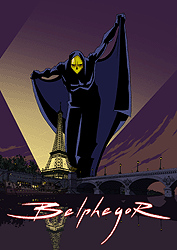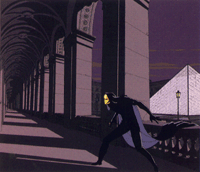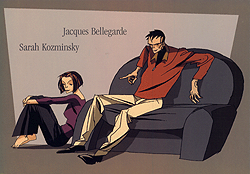The legend of Belphor has entranced France for years. Now France 2 and 3 bring the mysterious dark figure back to television, only this time, it's animated. Annick Teninge reports.

The story of Belphégor has fascinated the entire country of France since the '60s, with the introduction of a live-action television series that now belongs to France's cultural inheritance. Based on a novel written by Arthur Bernède in the '20s, the author took a mythological character from the recesses of antiquity and assigned him an identity that captured the imagination of the country when brought to television.
Today Belphégor is a 26 x 26-minute animated series co-produced by France Television (France 2 and France 3), Les Armateurs (France), Toocan (Canada) and Price RG (Korea). The story is of a mysterious phantom, Belphégor, that haunts Paris, from the Louvre museum to the Opera House to the city's catacombs, while being pursued by the Paris police chief and two valiant journalists, Jacques and Sarah, who try to confound his evil plans...Gérald Dupeyrot, who is also the script director, created the series. Jean-Christophe Roger directs it and Frédéric Bezian is the artistic director. The first episodes will broadcast on France 2 at the end of this year, while France Television Distribution has just released the first video of two episodes "Le Fantôme du templier" and "La preuve par 24."
The animated version is a modern, expressionistic adaptation of the live-action Belphégor series, with a strong graphic style. It successfully recreates an eerie universe, where even the city of lights becomes a haunting character. The series is also characterized by very ambitious scripts -- multi-layered stories that drag you along, losing you in the complexity of the characters and the excitement of the story and mysteries.
A public television network, France Television is the leading financier of animation programs in France. They are currently co-producing fourteen animation series, representing 116 hours of programming. France 2 targets 12-18 year olds, while France 3 targets the 4-10 age group. France Television centers its children's programming around two artistic lines: impertinent humor with series such as Baskerville: une famille d'enfer, Momie au pair and Norman Normal; and action and adventure, colored with French and European cultural inheritance, illustrated by Belphégor, Corto Maltese and Lucky Luke, among others. Les Armateurs, Belphégor's executive producer, is a French production company founded in 1994 by Didier Brunner. Among others, Les Armateurs co-produced Michel Ocelot's famed Kirikou And The Sorceress. They are currently working on Michel Ocelot's Princes & Princesses, as well as Sylvain Chomet's Les Triplettes de Belleville, an animated feature based on characters from Chomet's award-winning short The Old Lady and the Pigeons.

Creator Gérald Dupeyrot agreed to share his thoughts on his work:
Annick Teninge: How did you get the idea to bring back this mythic television series? Were you worried it would not be equal to your memories, and the viewers' memories, even if this concern was irrelevant for today's generation?
Gérald Dupeyrot:
To begin with, it was purely commercial. The production company was looking for an idea for a TV series. First, they considered Fantomas but the rights were not available. Then, Belphégor became an option. I pitched the idea to Pathé, the rights holders, and Arthur Bernède's heirs. They accepted it. However, for moral reasons, it was out of the question that Belphégor would kill, or even be a thief. We were told that no distributor would go for that. Even a project with "Robin Hood" in the title had discouraged investors, not to mention a thief! Plus, the C.S.A. (Conseil Superieur de l'Audiovisuel) [French Audiovisual Council, a regulation authority] had recently frowned on several projects with bad heroes and we needed to be very careful with the story line. And it was out of the question to follow the book, because it ends with Belphégor's death. The rights holders also imposed other constraints, such as never revealing Belphégor's identity. We had to be daring, but in a different way. This is why I made Belphégor what it is.

Once Pathé was convinced, we worked on a pilot, which was presented at the Cartoon Forum in Connemara [Ireland, 1996]. The day after the presentation, France 2 and France 3 announced they were willing to join the venture. Yet, the pilot was quite awful! I would like to say that our partners at France 2/3 have been fantastic, especially considering the particular nature of this series.
AT: From an artistic standpoint, did you feel that an animated version would bring some limitations -- to translate the mysterious aspect, among others -- or allow more creativity? And how did you choose the artistic director, who is extremely talented from my point of view?
GD: I have always felt that animation doesn't bring any constraints. On the opposite, it allows one to render a different vision of reality, to give more meaning to life by refining it and only keeping what is essential, and by playing with the time, etc. Of course, this is assuming one knows how to use it and has enough resources to reach the effect required. Films such as Jin Rô convinced me that animation has started to explore new roads that will become fabulous means of expression.
AT: Can you explain this?
GD: Jin Rô is Japanese director Hiroyuki Okiura's first feature. It is set in an imaginary post-war Japan, where a conspiracy threatens both police combat troopers and anti-government activists. Although, the technique is traditional, the style is very innovative in the way it uses a sharp, realistic graphic style to translate the atmosphere.

But, back to Belphégor: I was getting nowhere with the graphic design. We were only receiving proposals with very classical character design. They all looked like Titan A.E. or characters from semi-realistic-type movies. How could we transform these characters into a consistent universe? Which backgrounds would fit in? This is when I suggested bringing in Frédéric Bézian, a comic book artist I really liked and considered one of the most bewitching artists, although he did not have many fans at the time. His style, and the atmosphere in his comic books seemed to match perfectly my idea of Belphégor. Luckily, Frédéric accepted my proposal and became the artistic director of the series. He has been fantastic. Not only did he successfully adapt his relatively complex drawing style to the simplification needed in animation, but he also appeared to be extremely painstaking in his work, and thoughtful of other people's work. He is an incredibly talented professional.

AT: Belphégor, the title character, who has supernatural powers, is the bad guy. That's unusual compared to superheroes like Superman. Was the objective to show that children shouldn't idolize superheroes just because they possess supernatural powers?
GD: Belphégor doesn't have supernatural powers. His ring transfixes and temporary neutralizes people. But this already exists in military lab and is not very sophisticated. It was mostly added to emphasize the spectacular aspect, to make him more frightening. Belphégor's real weapons are his strength and his cleverness, which -- I'll grant you that -- is totally unusual in superhero stories. Indeed, he is a "bad" hero, but his elusiveness makes him quite threatening. This, plus the fact he is facing two positive and very endearing people (Sarah, one of the two journalists, most specifically), should prevent children from identifying with him and make them identify with his pursuers instead. It was interesting for us to see how Sarah stood out as we were working on the character development. She is the most impulsive and the most daring of the duo, and I believe children, especially girls, will strongly identify with her.
AT: How close did you stay to the book and the original TV series? In your script, the connection between the "old" Belphégor and today's is made through his reappearance, 30 years later. Did you play with that aspect -- the time lag -- in the script?
GD: Our Belphégor is quite different from the book character or the previous TV series. Plus, the story takes place in this day and age. I think that if we are true to something, it is to the atmosphere, to a character that is elusive -- physically and in his motivations -- unsettling, unpredictable. We devoted a lot of time to the writing. As opposed to the book -- where Belphégor's sole goal is to run off with a Merovingian treasure hidden in the Louvre museum -- our goal was to tell not one but twenty-six stories! And for each of them, to find a motivation which was not based on greed or the need for power, and did not portray him as capricious or pusillanimous. The writers, Marc Larmigny, together with Sébastien Viaud and Séverine Vuillaume, were able to invent stories which didn't look like we'd seen it all before, while integrating all the existing constraints.
From one episode to another, one will notice that Belphégor challenges people and situations all the time; one will conclude that he is a player, or a manipulator; or maybe that he behaves like an entomologist. He fits in with the history, with who Belphégor is, way before the book. He is a diabolical character who is also an enlightener of people's personalities. By provoking them, he makes them experience things that help them to grow, like in real life!
One episode, "La Vengeance de l'Etoile Bleue," [The Revenge of the Blue Star] gives away another essential trait of his personality. It was not possible to explain it literally, because the viewing audience is mostly children. However, we understand that Belphégor has suffered a bereavement that took away his reason for living. And instead of overcoming his mourning, or becoming insane, or an alcoholic, he steps aside and settles on the edge between life and death. He is constantly provoking life, as if he is waiting for a sign from her that might provoke an emotion within himself. Naturally, we could not translate these complex feelings in the film. So, we merely acknowledge the effects of the distance he puts between himself and rest of the world.

AT: Is it true that, in the antiquity, Belphégor was pictured in two quite different fashions: "as a beautiful naked woman and as a monstrous, bearded demon with an open mouth, horns, and sharply pointed nails. Belphégor was Hell's ambassador to France"?
GD: I don't know where this citation comes from. What's for sure is that, from the antiquity, the name, Belphégor [Baal-peor] refers to one of the avatars of the God Baal. And quite a few authors, including Machiavel, have portrayed him. At the beginning, Belphégor was a demon from an ancient civilization in the Middle East, and his name means "Demon of the mountain." Then, we track him to Carthage, hence the Tanit sign, which is Belphégor's mark. This is not clarified in the series, however the Tanit sign can be compared to that of Belphégor's imploring doll, with her arms up in the air, and to his music box. If both of them are superposed, their shape matches the Tanit sign. This doll is part of Belphégor's mystery. Obviously, it is a relic from the time when his frosty desperation arose.
AT: There are quite a few veiled references: Jacques Drouin, Gerard Majax.
GD: That's true. In one episode, people have the ability to go through the paintings at the Louvre museum -- it is the only time where the transgression of physical laws leads to this level of fantasy -- and I got the idea while thinking of one of Jacques Drouin's films Le Paysagiste (The Landscape Architect). Thus, I figured it was just fair to pay tribute to the author by naming the "magic painter" after him. But, apart from a few animation groupies like you and me, had we not mentioned it, who would have noticed? Same thing with Gerard Magix, a transparent allusion to Gerard Majax, a fearsome destroyer of telekinesis in the '70s. And there are many of them. But, in most cases, they are veiled messages to nobody. It's just that, at some point, you need to come up with a name. For instance, I named the main female character Sarah, and her surname is Kozminsky. Who knows why?
Don't forget to check back with us. Belphegor Quicktime clips are on their way!
Interview with Gérald Dupeyrot conducted in French and translated by Annick Teninge.
Annick Teninge is the general manager of Animation World Network. A French native, Annick began her animation career as Assistant Director at the Annecy International Animation Festival, a post she held for six years.







